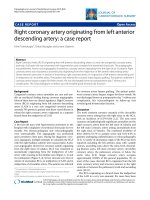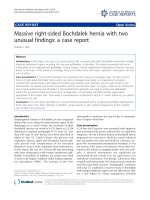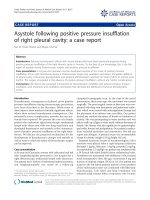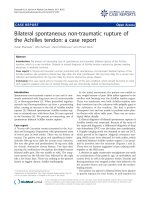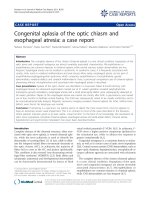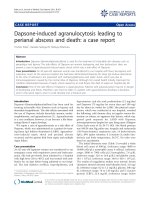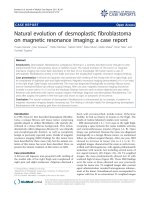Báo cáo y học: " Benign cervical multi-nodular goiter presenting with acute airway obstruction: a case report" docx
Bạn đang xem bản rút gọn của tài liệu. Xem và tải ngay bản đầy đủ của tài liệu tại đây (571.64 KB, 4 trang )
CAS E REP O R T Open Access
Benign cervical multi-nodular goiter presenting
with acute airway obstruction: a case report
Anu Sharma, Vijay Naraynsingh
*
, Surujpaul Teelucksingh
Abstract
Introduction: Benign cervical goiters rarely cause acute airway obstruction.
Case presentation: We report the case of a 64-year-old woman of African descent who presented with acute
shortness of breath. She required immediate intubation and later a total thyroidectomy for a benign cervical multi-
nodular goiter with no retrosternal tracheal compression.
Conclusion: Benign multi-nodular goiters are commonly left untreated once euthyroid. Peak inspiratory flow rates
should be measured via spirometry in all goiters to assess the degree of tracheal compression. Once tracheal
compression is identified, an elective total thyroidectomy should be performed to prevent morbidity and mortality
from acute airway obstruction.
Introduction
Benign multi-nodular goiter is a common problem affect-
ing 5% of the general population in non-endemic and
15% [1] in endemic areas. However, the incidence of
benign goiter causing acute airway obstruction is as low
as 0.6% [2]. Retrosternal goiters account for most of
these cases, as growth of the thyroid into the bony rigid
thoracic inlet can cause tracheal compression. When a
goiter is purely cervical, however, it rarely compresses
the trachea to cause obstruction [3]. On review of the lit-
erature, only eight reports of cervical goiters causing air-
way obstruction were found [3-6]. Here, we present the
case of a patient with recurrent benign cervical multi-
nodular goiter presenting with acute airway obstruction.
Case presentation
A 64-year-old hypertensive woman of African descent
presented to our emergency room with a two-day his-
tory of worsening shortness of breath and stridor. She
had b een aware of a recurrent goiter for over 15 years,
having had a partial thyroidectomy 35 years ago for
benign multi-nodular disease. Over the past year, she
had been experiencing shortness of breath on exertion,
generally relieved by rest. However, the period of rest
needed to relieve her dyspnea had been increasing in
duration. She did not have any hyperthyroid or
hypothyroid symptoms and there w as no history of
fever, dysphagia, pain or hoarseness.
On presentation to our emergency department she had
marked stridor, tachypnea (32 breaths/minute), tachycar-
dia (120 beats/minute) and blood pressure of 160 /95
mmHg. Her pulse oximeter oxygen saturation (spO
2
) was
78% on room air. A large multi-nodular goiter was
obvious: right lobe 14×11 cm, left lobe 11×8 cm (Figure
1). All other examinations were normal. She was rushed
to the operating theatre for intubation under general
anesthesia. A central line was also placed via the right
subclavian vein. On intubation, the larynx appeared nor-
mal and a 7.5Fr endotracheal tube (ET) was passed easily.
After intubation, she stabilized and was able to
breathe comfortably with the ET in situ.Shewas
admitted to the intensive care unit and given propanolol
20 mg orally, three times daily. Her laboratory test
results were within normal ranges, with a thyroid-stimu-
lating hormone (TSH) level of 1.4 mIU/L and free T4
level of 1.5 μg/dL. A computed tomography (CT) scan
of the neck and thorax showed gross enlargement of
both lobes of the thyroid with multiple nodules of vary-
ing sizes. There was marked narrowing of the cervical
trachea with only the ET maintaining the patency of the
airway (Figure 2). There was mild retrosternal extension
on the left side down to the level of the origin of the
great vessels but the retrosternal trachea was not
* Correspondence:
Faculty of the Medical Sciences, University of the West Indies, St. Augustine,
Trinidad & Tobago
Sharma et al. Journal of Medical Case Reports 2010, 4:258
/>JOURNAL OF MEDICAL
CASE REPORTS
© 2010 Sharma et al; licensee BioMed Central Ltd. This is an Open Access article distributed und er the terms of the Creative Commons
Attribution License ( s/by/2.0), which permits unrestricted use, distr ibution, and reprod uction in
any medium, provid ed the original work is properly cited.
compressed (Figure 3). The results of an electrocardio-
gram (ECG) were normal, while the results of an echo-
cardiogram were consistent with hypertensive heart
disease with an ejection fraction of 65%.
A total thyroidectomy was performed on the fourth
day after admission. The gland was diss ected easily with
preservation of the recurrent laryngeal nerves and para-
thyroids. A tracheo stomy was placed prophylactically.
The trachea was normal with no features of tracheoma-
lacia. She returned to our intensive care unit and recov-
ered with no complications. Her calcium levels did not
decline post-operatively. The tracheostomy was removed
on day 10 post-operatively. Histology tests confirmed a
benign multi-nodular goiter.
Discussion
Acute airway obstruction has been described extensively
for re trosternal benign goiters and thyroid malignancies.
Benign cervical goiters causing acute airwa y obstruction
are rare. Reports have been published s uggesting acute
obstruction to be due to sudden hemorrhage into a cyst,
an upper respiratory tract infection causing edema, tra-
cheal collapse or worsening of a medical illness [3,6-9].
In our case, all the above causes had been ruled out.
Jauregui et al. [7] suggested u pper airway obstruction
due to goiter is frequently u nder-diagnosed. The pro-
gressive, insidious growth experienced allows the patient
time to compensate for up to 70% of tracheal compres-
sion [3]. If specific questions were asked, 45% of patients
said they had shortness of breath on either exertion or
when in a supine posture [7]. Compromised airflow in
patients who are asymptomatic has been proven by
spirometry [6-8]. Peak inspiratory flow rates have been
shown to be a good indicator for urgent thyroidectomy
[9]. Using spirometry as a screening tool, the incidence
of upper airway obstruction ranged from 10% to 31%
[8]. In all cases, partial or total thyroidectomies were
definitive cures to relieve obstruction.
Figure 1 Large beni gn mu lti-nodular goiter. The figure illustrates the size of the large multi-nodular goiter that our patient presented with.
This goiter measured 14×11 cm (right lobe) and 11×8 cm (left lobe). No retrosternal goiter was found on examination. Our patient was
intubated and on the ventilator with a central line in place on the right.
Sharma et al. Journal of Medical Case Reports 2010, 4:258
/>Page 2 of 4
Figure 2 A computed tomography (CT) scan at the level of C7 showing the endotracheal tube flush with the wall of the trachea. The
diameter of the tracheal lumen measured 7.5 mm with the endotracheal tube in situ maintaining its patency. Compare the tracheal diameter in
this image with Figure 3.
Figure 3 A computed tomography (CT) scan at the level of T2 showing the endotracheal tube situated within the tracheal lumen. The
tracheal diameter was 2 cm at this level. No retrosternal tracheal compression was evident as compared to Figure 2. There was mild retrosternal
extension on the left down to the level of the great vessels. A central venous line was noted on the right.
Sharma et al. Journal of Medical Case Reports 2010, 4:258
/>Page 3 of 4
In our patient, spirometry could have identified our
patient’s compromised respiration but life-saving, urgent
intubation was essential. She developed stridor and wor-
sening dyspnea ove r a two-day period suggesting pro-
gressive compromise of the tracheal lumen. In spite of
the goiter’ s large size, no structural tracheal defect was
evident at intubation or surgery. This suggests purely
mechanical compressi on of the trachea by the huge goi-
ter within the firm, unyielding cervical fascia, causing
her upper airway obstruction.
Her symptoms had been worsening over a year-long
period. The slow growth rate of the thyroid gland allows
adaptation to extrinsic hypoventilation without acute
symptoms [9]. Therefore, in keeping with previous
reports, a patient who is asymptomatic with a large
multi-nodular goiter should not be taken lightly. The
possibility of acute airway obstruction should be dis-
cussed, spirometry performed and an elective thyroi-
dectomy offered to patients with large goiters even with
lesser grades of compressive symptomatology.
Conclusion
Benign euthyroid multi-nodular goiters are common.
The incidence of acute airway obstruction due t o a
benign goiter, however, is quite low, with cases due to
purely cervical goiters being rare. This has allowed phy-
sicians a conservative approach to management. On
review of the literature, however, tracheal compression
with decreased inspiratory flow rates are found in one-
third of cases. The management of benign cervical
multi-nodular g oiters should include inspiratory spiro-
metry. Once compromised airflow is identi fied, prophy-
lactic total thyroidectomy should be performed to avoid
the dangers of complete airway obstruction.
Consent
Written informed consent was obtained from the patient for publication of
this case report and any accompanying images. A copy of the written
consent is available for review by the Editor-in-Chief of this journal.
Competing interests
The authors declare that they have no competing interests.
Authors’ contributions
ST and AS provided medical assistance to the case and VN provided surgical
findings. AS and VN performed the literature search and major contributors
to writing the manuscript. ST and VN edited the manuscript. All authors
have read and approved the final manuscript.
Received: 24 October 2009 Accepted: 10 August 2010
Published: 10 August 2010
References
1. Abraham D, Singh N, Lang B, Chan WF, Lo CY: Benign nodular goiter
presenting as acute airway obstruction. ANZ J Surg 2007, 77:364-367.
2. Ríos A, RodrÍguez JM, Canteras M, Galindo PJ, Tebar FJ, Parrilla P: Surgical
management of multinodular goiter with compressive symptoms. Arch
Surg 2005, 140:49-53.
3. Sajja LR, Mannam GC, Sompalli S, Simhadri CSR, Hasan A: Multinodular
goiter compressing the trachea following open heart surgery. Asian
Cardiovasc Thorac Ann 2006, 14:416-417.
4. Tseng KH, Felicetta JV, Rydstedt LL, Bouwman DG, Sowers JR: Acute airway
obstruction due to a benign cervical goiter. Otolaryngol Head Neck Surg
1987, 97:72-75.
5. Shaha AR: Surgery for benign thyroid disease causing trachea-
oesophageal compression. Otolaryngol Clin North Am 1990, 23:391-401.
6. Melliere D, Saada F, Etienne G, Becquemin JP, Bonnet F: Goitre with severe
respiratory compromise: evaluation and treatment. Surgery 1988,
103:367-373.
7. Ríos A, Rodríguez JM, Galindo PJ, Cascales PA, Blasalobre M, Parilla P:
Spirometric evaluation of respiratory involvement in asymptomatic
multinodular goiter with an intrathoracic component. Arch
Bronchoneumol 2008, 44:504-506.
8. Karbowitz SR, Edelman LB, Nath S, Dwek JH, Rammohan G: Spectrum of
advanced upper airway obstruction due to goitres. Chest 1985, 87:18-21.
9. Miller MR, Pincock AC, Oates GD, Wilkinson R, Skene-Smith H: Upper airway
obstruction due to goiter: detection, prevalence and results of surgical
management. QJ Med 1990, 74:177-188.
doi:10.1186/1752-1947-4-258
Cite this article as: Sharma et al.: Benign cervical multi-nodular goiter
presenting with acute airway obstruction: a case report. Journal of
Medical Case Reports 2010 4:258.
Submit your next manuscript to BioMed Central
and take full advantage of:
• Convenient online submission
• Thorough peer review
• No space constraints or color figure charges
• Immediate publication on acceptance
• Inclusion in PubMed, CAS, Scopus and Google Scholar
• Research which is freely available for redistribution
Submit your manuscript at
www.biomedcentral.com/submit
Sharma et al. Journal of Medical Case Reports 2010, 4:258
/>Page 4 of 4

